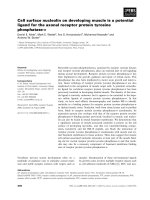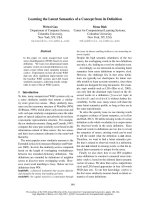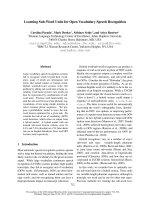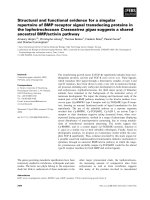Báo cáo khoa học: "Learning Surface Text Patterns for a Question Answering System" doc
Bạn đang xem bản rút gọn của tài liệu. Xem và tải ngay bản đầy đủ của tài liệu tại đây (39.36 KB, 7 trang )
Learning Surface Text Patterns
for a Question Answering System
Deepak Ravichandran and Eduard Hovy
Information Sciences Institute
University of Southern California
4676 Admiralty Way
Marina del Rey, CA 90292-6695
USA
{ravichan,hovy}@isi.edu
Abstract
In this paper we explore the power of
surface text patterns for open-domain
question answering systems. In order to
obtain an optimal set of patterns, we have
developed a method for learning such
patterns automatically. A tagged corpus
is built from the Internet in a
bootstrapping process by providing a few
hand-crafted examples of each question
type to Altavista. Patterns are then
automatically extracted from the returned
documents and standardized. We
calculate the precision of each pattern,
and the average precision for each
question type. These patterns are then
applied to find answers to new questions.
Using the TREC-10 question set, we
report results for two cases: answers
determined from the TREC-10 corpus
and from the web.
1 Introduction
Most of the recent open domain question-
answering systems use external knowledge
and tools for answer pinpointing. These may
include named entity taggers, WordNet,
parsers, hand-tagged corpora, and ontology
lists (Srihari and Li, 00; Harabagiu et al., 01;
Hovy et al., 01; Prager et al., 01). However, at
the recent TREC-10 QA evaluation
(Voorhees, 01), the winning system used just
one resource: a fairly extensive list of surface
patterns (Soubbotin and Soubbotin, 01). The
apparent power of such patterns surprised
many. We therefore decided to investigate
their potential by acquiring patterns
automatically and to measure their accuracy.
It has been noted in several QA systems
that certain types of answer are expressed
using characteristic phrases (Lee et al., 01;
Wang et al., 01). For example, for
BIRTHDATEs (with questions like “When
was X born?”), typical answers are
“Mozart was born in 1756.”
“Gandhi (1869–1948)…”
These examples suggest that phrases like
“<NAME> was born in <BIRTHDATE>”
“<NAME> (<BIRTHDATE>–”
when formulated as regular expressions, can
be used to locate the correct answer.
In this paper we present an approach for
automatically learning such regular
expressions (along with determining their
precision) from the web, for given types of
questions. Our method uses the machine
learning technique of bootstrapping to build a
large tagged corpus starting with only a few
examples of QA pairs. Similar techniques
have been investigated extensively in the field
of information extraction (Riloff, 96). These
techniques are greatly aided by the fact that
there is no need to hand-tag a corpus, while
the abundance of data on the web makes it
easier to determine reliable statistical
estimates.
Our system assumes each sentence to be a
simple sequence of words and searches for
repeated word orderings as evidence for
Computational Linguistics (ACL), Philadelphia, July 2002, pp. 41-47.
Proceedings of the 40th Annual Meeting of the Association for
useful answer phrases. We use suffix trees
for extracting substrings of optimal length.
We borrow the idea of suffix trees from
computational biology (Gusfield, 97) where it
is primarily used for detecting DNA
sequences. Suffix trees can be processed in
time linear on the size of the corpus and, more
importantly, they do not restrict the length of
substrings. We then test the patterns learned
by our system on new unseen questions from
the TREC-10 set and evaluate their results to
determine the precision of the patterns.
2 Learning of Patterns
We describe the pattern-learning algorithm
with an example. A table of patterns is
constructed for each individual question type
by the following procedure (Algorithm 1).
1. Select an example for a given question
type. Thus for BIRTHYEAR questions we
select “Mozart 1756” (we refer to
“Mozart” as the question term and “1756”
as the answer term).
2. Submit the question and the answer term
as queries to a search engine. Thus, we
give the query +“Mozart” +“1756” to
AltaVista ().
3. Download the top 1000 web documents
provided by the search engine.
4. Apply a sentence breaker to the
documents.
5. Retain only those sentences that contain
both the question and the answer term.
Tokenize the input text, smooth variations
in white space characters, and remove html
and other extraneous tags, to allow simple
regular expression matching tools such as
egrep to be used.
6. Pass each retained sentence through a
suffix tree constructor. This finds all
substrings, of all lengths, along with their
counts. For example consider the
sentences “The great composer Mozart
(1756–1791) achieved fame at a young
age” “Mozart (1756–1791) was a genius”,
and “The whole world would always be
indebted to the great music of Mozart
(1756–1791)”. The longest matching
substring for all 3 sentences is “Mozart
(1756–1791)”, which the suffix tree would
extract as one of the outputs along with the
score of 3.
7. Pass each phrase in the suffix tree through
a filter to retain only those phrases that
contain both the question and the answer
term. For the example, we extract only
those phrases from the suffix tree that
contain the words “Mozart” and “1756”.
8. Replace the word for the question term by
the tag “<NAME>” and the word for the
answer term by the term “<ANSWER>”.
This procedure is repeated for different
examples of the same question type. For
BIRTHDATE we also use “Gandhi 1869”,
“Newton 1642”, etc.
For BIRTHDATE, the above steps
produce the following output:
a. born in <ANSWER> , <NAME>
b. <NAME> was born on <ANSWER> ,
c. <NAME> ( <ANSWER> -
d. <NAME> ( <ANSWER - )
These are some of the most common
substrings of the extracted sentences that
contain both <NAME> and <ANSWER>.
Since the suffix tree records all substrings,
partly overlapping strings such as c and d are
separately saved, which allows us to obtain
separate counts of their occurrence
frequencies. As will be seen later, this allows
us to differentiate patterns such as d (which
records a still living person, and is quite
precise) from its more general substring c
(which is less precise).
Algorithm 2: Calculating the precision of each
pattern.
1. Query the search engine by using only the
question term (in the example, only
“Mozart”).
2. Download the top 1000 web documents
provided by the search engine.
3. As before, segment these documents into
individual sentences.
4. Retain only those sentences that contain
the question term.
5. For each pattern obtained from Algorithm
1, check the presence of each pattern in the
sentence obtained from above for two
instances:
i) Presence of the pattern with
<ANSWER> tag matched by any
word.
ii) Presence of the pattern in the sentence
with <ANSWER> tag matched by the
correct answer term.
In our example, for the pattern “<NAME>
was born in <ANSWER>” we check the
presence of the following strings in the
answer sentence
i) Mozart was born in <ANY_WORD>
ii) Mozart was born in 1756
Calculate the precision of each pattern by
the formula P = C
a
/ C
o
where
C
a
= total number of patterns with the
answer term present
C
o
= total number of patterns present
with answer term replaced by any word
6. Retain only the patterns matching a
sufficient number of examples (we choose
the number of examples > 5).
We obtain a table of regular expression
patterns for a given question type, along with
the precision of each pattern. This precision
is the probability of each pattern containing
the answer and follows directly from the
principle of maximum likelihood estimation.
For BIRTHDATE the following table is
obtained:
1.0 <NAME>( <ANSWER> - )
0.85 <NAME> was born on <ANSWER>,
0.6 <NAME> was born in <ANSWER>
0.59 <NAME> was born <ANSWER>
0.53 <ANSWER> <NAME> was born
0.50 – <NAME> ( <ANSWER>
0.36 <NAME> ( <ANSWER> -
For a given question type a good range of
patterns was obtained by giving the system as
few as 10 examples. The rather long list of
patterns obtained would have been very
difficult for any human to come up with
manually.
The question term could appear in the
documents obtained from the web in various
ways. Thus “Mozart” could be written as
“Wolfgang Amadeus Mozart”, “Mozart,
Wolfgang Amadeus”, “Amadeus Mozart” or
“Mozart”. To learn from such variations, in
step 1 of Algorithm 1 we specify the various
ways in which the question term could be
specified in the text. The presence of any of
these names would cause it to be tagged as the
original question term “Mozart”.
The same arrangement is also done for the
answer term so that presence of any variant of
the answer term would cause it to be treated
exactly like the original answer term. While
easy to do for BIRTHDATE, this step can be
problematic for question types such as
DEFINITION, which may contain various
acceptable answers. In general the input
example terms have to be carefully selected
so that the questions they represent do not
have a long list of possible answers, as this
would affect the confidence of the precision
scores for each pattern. All the answers need
to be enlisted to ensure a high confidence in
the precision score of each pattern, in the
present framework.
The precision of the patterns obtained
from one QA-pair example in algorithm 1 is
calculated from the documents obtained in
algorithm 2 for other examples of the same
question type. In other words, the precision
scores are calculated by cross-checking the
patterns across various examples of the same
type. This step proves to be very significant
as it helps to eliminate dubious patterns,
which may appear because the contents of
two or more websites may be the same, or the
same web document reappears in the search
engine output for algorithms 1 and 2.
Algorithm 1 does not explicitly specify
any particular question type. Judicious choice
of the QA example pair therefore allows it to
be used for many question types without
change.
3 Finding Answers
Using the patterns to answer a new question
we employ the following algorithm:
1. Determine the question type of the new
question. We use our existing QA system
(Hovy et al., 2002b; 2001) to do so.
2. The question term in the question is
identified, also using our existing system.
3. Create a query from the question term and
perform IR (by using a given answer
document corpus such as the TREC-10
collection or web search otherwise).
4. Segment the documents obtained into
sentences and smooth out white space
variations and html and other tags, as
before.
5. Replace the question term in each sentence
by the question tag (“<NAME>”, in the
case of BIRTHYEAR).
6. Using the pattern table developed for that
particular question type, search for the
presence of each pattern. Select words
matching the tag “<ANSWER>” as the
answer.
7. Sort these answers by their pattern’s
precision scores. Discard duplicates (by
elementary string comparisons). Return
the top 5 answers.
4 Experiments
From our Webclopedia QA Typology
(Hovy et al., 2002a) we selected 6 different
question types: BIRTHDATE, LOCATION,
INVENTOR, DISCOVERER, DEFINITION,
WHY-FAMOUS. The pattern table for each
of these question types was constructed using
Algorithm 1.
Some of the patterns obtained along with
their precision are as follows
BIRTHYEAR
1.0 <NAME> ( <ANSWER> - )
0.85
<NAME> was born on <ANSWER> ,
0.6 <NAME> was born in <ANSWER>
0.59
<NAME> was born <ANSWER>
0.53
<ANSWER> <NAME> was born
0.5 - <NAME> ( <ANSWER>
0.36
<NAME> ( <ANSWER> -
0.32
<NAME> ( <ANSWER> ) ,
0.28
born in <ANSWER> , <NAME>
0.2 of <NAME> ( <ANSWER>
INVENTOR
1.0 <ANSWER> invents <NAME>
1.0 the <NAME> was invented by
<ANSWER>
1.0 <ANSWER> invented the <NAME> in
1.0 <ANSWER> ' s invention of the
<NAME>
1.0 <ANSWER> invents the <NAME> .
1.0 <ANSWER> ' s <NAME> was
1.0 <NAME> , invented by <ANSWER>
1.0 <ANSWER> ' s <NAME> and
1.0 that <ANSWER> ' s <NAME>
1.0 <NAME> was invented by <ANSWER> ,
DISCOVERER
1.0 when <ANSWER> discovered
<NAME>
1.0 <ANSWER> ' s discovery of <NAME>
1.0 <ANSWER> , the discoverer of
<NAME>
1.0 <ANSWER> discovers <NAME> .
1.0 <ANSWER> discover <NAME>
1.0 <ANSWER> discovered <NAME> , the
1.0 discovery of <NAME> by <ANSWER>.
0.95
<NAME> was discovered by
<ANSWER>
0.91
of <ANSWER> ' s <NAME>
0.9 <NAME> was discovered by
<ANSWER> in
DEFINITION
1.0 <NAME> and related <ANSWER>s
1.0 <ANSWER> ( <NAME> ,
1.0 <ANSWER> , <NAME> .
1.0 , a <NAME> <ANSWER> ,
1.0 ( <NAME> <ANSWER> ) ,
1.0 form of <ANSWER> , <NAME>
1.0 for <NAME> , <ANSWER> and
1.0 cell <ANSWER> , <NAME>
1.0 and <ANSWER> > <ANSWER> >
<NAME>
0.94
as <NAME> , <ANSWER> and
WHY-FAMOUS
1.0 <ANSWER> <NAME> called
1.0 laureate <ANSWER> <NAME>
1.0 by the <ANSWER> , <NAME> ,
1.0 <NAME> - the <ANSWER> of
1.0 <NAME> was the <ANSWER> of
0.84
by the <ANSWER> <NAME> ,
0.8 the famous <ANSWER> <NAME> ,
0.73
the famous <ANSWER> <NAME>
0.72
<ANSWER> > <NAME>
0.71
<NAME> is the <ANSWER> of
LOCATION
1.0 <ANSWER> ' s <NAME> .
1.0 regional : <ANSWER> : <NAME>
1.0 to <ANSWER> ' s <NAME> ,
1.0 <ANSWER> ' s <NAME> in
1.0 in <ANSWER> ' s <NAME> ,
1.0 of <ANSWER> ' s <NAME> ,
1.0 at the <NAME> in <ANSWER>
0.96
the <NAME> in <ANSWER> ,
0.92
from <ANSWER> ' s <NAME>
0.92
near <NAME> in <ANSWER>
For each question type, we extracted the
corresponding questions from the TREC-10
set. These questions were run through the
testing phase of the algorithm. Two sets of
experiments were performed. In the first
case, the TREC corpus was used as the input
source and IR was performed by the IR
component of our QA system (Lin, 2002). In
the second case, the web was the input source
and the IR was performed by the AltaVista
search engine.
Results of the experiments, measured by
Mean Reciprocal Rank (MRR) score
(Voorhees, 01), are:
TREC Corpus
Question type Number of
questions
MRR on
TREC docs
BIRTHYEAR 8 0.48
INVENTOR 6 0.17
DISCOVERER 4 0.13
DEFINITION 102 0.34
WHY-FAMOUS 3 0.33
LOCATION 16 0.75
Web
Question type Number of
questions
MRR on the
Web
BIRTHYEAR 8 0.69
INVENTOR 6 0.58
DISCOVERER 4 0.88
DEFINITION 102 0.39
WHY-FAMOUS 3 0.00
LOCATION 16 0.86
The results indicate that the system
performs better on the Web data than on the
TREC corpus. The abundance of data on the
web makes it easier for the system to locate
answers with high precision scores (the
system finds many examples of correct
answers among the top 20 when using the
Web as the input source). A similar result for
QA was obtained by Brill et al. (2001). The
TREC corpus does not have enough candidate
answers with high precision score and has to
settle for answers extracted from sentences
matched by low precision patterns. The
WHY-FAMOUS question type is an
exception and may be due to the fact that the
system was tested on a small number of
questions.
5 Shortcoming and Extensions
No external knowledge has been added to
these patterns. We frequently observe the
need for matching part of speech and/or
semantic types, however. For example, the
question: “Where are the Rocky Mountains
located?” is answered by “Denver’s new
airport, topped with white fiberglass cones in
imitation of the Rocky Mountains in the
background, continues to lie empty”, because
the system picked the answer “the
background” using the pattern “the <NAME>
in <ANSWER>,”. Using a named entity
tagger and/or an ontology would enable the
system to use the knowledge that
“background” is not a location.
DEFINITION questions pose a related
problem. Frequently the system’s patterns
match a term that is too general, though
correct technically. For “what is nepotism?”
the pattern “<ANSWER>, <NAME>”
matches “…in the form of widespread
bureaucratic abuses: graft, nepotism…”; for
“what is sonar?” the pattern “<NAME> and
related <ANSWER>s” matches “…while its
sonar and related underseas systems are
built…”.
The patterns cannot handle long-distance
dependencies. For example, for “Where is
London?” the system cannot locate the answer
in “London, which has one of the most busiest
airports in the world, lies on the banks of the
river Thames” due to the explosive danger of
unrestricted wildcard matching, as would be
required in the pattern “<QUESTION>,
(<any_word>)*, lies on <ANSWER>”. This
is one of the reasons why the system performs
very well on certain types of questions from
the web but performs poorly with documents
obtained from the TREC corpus. The
abundance and variation of data on the
Internet allows the system to find an instance
of its patterns without losing answers to long-
term dependencies. The TREC corpus, on the
other hand, typically contains fewer candidate
answers for a given question and many of the
answers present may match only long-term
dependency patterns.
More information needs to be added to the
text patterns regarding the length of the
answer phrase to be expected. The system
searches in the range of 50 bytes of the
answer phrase to capture the pattern. It fails to
perform under certain conditions as
exemplified by the question “When was
Lyndon B. Johnson born?”. The system
selects the sentence “Tower gained national
attention in 1960 when he lost to democratic
Sen. Lyndon B. Johnson, who ran for both re-
election and the vice presidency” using the
pattern “<NAME> <ANSWER> –“. The
system lacks the information that the
<ANSWER> tag should be replaced exactly
by one word. Simple extensions could be
made to the system so that instead of
searching in the range of 50 bytes for the
answer phrase it could search for the answer
in the range of 1–2 chunks (basic phrases in
English such as simple NP, VP, PP, etc.).
A more serious limitation is that the
present framework can handle only one
anchor point (the question term) in the
candidate answer sentence. It cannot work for
types of question that require multiple words
from the question to be in the answer
sentence, possibly apart from each other. For
example, in “Which county does the city of
Long Beach lie?”, the answer “Long Beach is
situated in Los Angeles County” requires the
pattern. “<QUESTION_TERM_1> situated in
<ANSWER> <QUESTION_TERM_2>”,
where <QUESTION_TERM_1> and
<QUESTION_TERM_2> represent the terms
“Long Beach” and “county” respectively.
The performance of the system depends
significantly on there being only one anchor
word, which allows a single word match
between the question and the candidate
answer sentence. The presence of multiple
anchor words would help to eliminate many
of the candidate answers by simply using the
condition that all the anchor words from the
question must be present in the candidate
answer sentence.
The system does not classify or make any
distinction between upper and lower case
letters. For example, “What is micron?” is
answered by “In Boise, Idaho, a spokesman
for Micron, a maker of semiconductors, said
Simms are ‘ a very high volume product for
us …’ ”. The answer returned by the system
would have been perfect if the word “micron”
had been capitalized in the question.
Canonicalization of words is also an issue.
While giving examples in the bootstrapping
procedure, say, for BIRTHDATE questions,
the answer term could be written in many
ways (for example, Gandhi’s birth date can be
written as “1869”, “Oct. 2, 1869”, “2nd
October 1869”, “October 2 1869”, and so
on). Instead of enlisting all the possibilities a
date tagger could be used to cluster all the
variations and tag them with the same term.
The same idea could also be extended for
smoothing out the variations in the question
term for names of persons (Gandhi could be
written as “Mahatma Gandhi”, “Mohandas
Karamchand Gandhi”, etc.).
6 Conclusion
The web results easily outperform the
TREC results. This suggests that there is a
need to integrate the outputs of the Web and
the TREC corpus. Since the output from the
Web contains many correct answers among
the top ones, a simple word count could help
in eliminating many unlikely answers. This
would work well for question types like
BIRTHDATE or LOCATION but is not clear
for question types like DEFINITION.
The simplicity of this method makes it
perfect for multilingual QA. Many tools
required by sophisticated QA systems (named
entity taggers, parsers, ontologies, etc.) are
language specific and require significant
effort to adapt to a new language. Since the
answer patterns used in this method are
learned using only a small number of manual
training terms, one can rapidly learn patterns
for new languages, assuming the web search
engine is appropriately switched.
Acknowledgements
This work was supported by the Advanced
Research and Development Activity
(ARDA)'s Advanced Question Answering for
Intelligence (AQUAINT) Program under
contract number MDA908-02-C-0007.
References
Brill, E., J. Lin, M. Banko, S. Dumais, and A. Ng.
2001. Data-Intensive Question Answering.
Proceedings of the TREC-10 Conference.
NIST, Gaithersburg, MD, 183–189.
Gusfield, D. 1997. Algorithms on Strings, Trees
and Sequences: Computer Science and
Computational Biology. Chapter 6: Linear
Time construction of Suffix trees, 94–121.
Harabagiu, S., D. Moldovan, M. Pasca, R.
Mihalcea, M. Surdeanu, R. Buneascu, R. Gîrju,
V. Rus and P. Morarescu. 2001. FALCON:
Boosting Knowledge for Answer Engines.
Proceedings of the 9
th
Text Retrieval
Conference (TREC-9), NIST, 479–488.
Hovy, E.H., U. Hermjakob, and C Y. Lin. 2001.
The Use of External Knowledge in Factoid
QA. Proceedings of the TREC-10
Conference. NIST, Gaithersburg, MD, 166–
174.
Hovy, E.H., U. Hermjakob, and D. Ravichandran.
2002a. A Question/Answer Typology with
Surface Text Patterns. Proceedings of the
Human Language Technology (HLT)
conference. San Diego, CA.
Hovy, E.H., U. Hermjakob, C Y. Lin, and D.
Ravichandran. 2002b. Using Knowledge to
Facilitate Pinpointing of Factoid Answers.
Proceedings of the COLING-2002 conference.
Taipei, Taiwan.
Lee, G.G., J. Seo, S. Lee, H. Jung, B-H. Cho, C.
Lee, B-K. Kwak, J, Cha, D. Kim, J-H. An, H.
Kim, and K. Kim. 2001. SiteQ: Engineering
High Performance QA System Using Lexico-
Semantic Pattern Matching and Shallow NLP.
Proceedings of the TREC-10 Conference.
NIST, Gaithersburg, MD, 437–446.
Lin, C-Y. 2002. The Effectiveness of Dictionary
and Web-Based Answer Reranking.
Proceedings of the COLING-2002 conference.
Taipei, Taiwan.
Prager, J. and J. Chu-Carroll. 2001. Use of
WordNet Hypernyms for Answering What-Is
Questions. Proceedings of the TREC-10
Conference. NIST, Gaithersburg, MD, 309–
316.
Riloff, E. 1996. Automatically Generating
Extraction Patterns from Untagged Text.
Proceedings of the Thirteenth National
Conference on Artificial Intelligence (AAAI-
96), 1044–1049.
Soubbotin, M.M. and S.M. Soubbotin. 2001.
Patterns of Potential Answer Expressions as
Clues to the Right Answer. Proceedings of the
TREC-10 Conference. NIST, Gaithersburg,
MD, 175–182.
Srihari, R. and W. Li. 2000. A Question
Answering System Supported by Information
Extraction. Proceedings of the 1
st
Meeting of
the North American Chapter of the Association
for Computational Linguistics (ANLP-
NAACL-00), Seattle, WA, 166–172.
Voorhees, E. 2001. Overview of the Question
Answering Track. Proceedings of the TREC-10
Conference. NIST, Gaithersburg, MD, 157–
165.
Wang, B., H. Xu, Z. Yang, Y. Liu, X. Cheng, D.
Bu, and S. Bai. 2001. TREC-10 Experiments at
CAS-ICT: Filtering, Web, and QA.
Proceedings of the TREC-10 Conference.
NIST, Gaithersburg, MD, 229–241.









